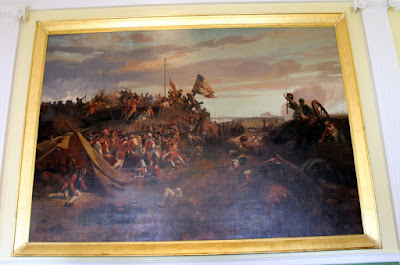We did a day trip with Richard and Valerie to tour the Virginia capitol and check out a bit of Richmond. The capitol not only serves as the state capitol but was also the capitol of the confederacy during the Civil War.
The center part is in the design of a Roman Temple. That original building was designed by Thomas Jefferson. Construction started in 1785 making it the second oldest capitol in the country. The East and West Wings were added in 1906 to house new chambers for the Senate and House of Delegates.
A new visitors center, which includes legislative meeting rooms, was added in 2007 by removing all of the hill in front of the capitol and then covering the new structure to keep the historic look of the capitol and grounds.
Thomas Jefferson not only wrote the Declaration of Independence and served as an ambassador, Vice President and President, he also served Virginia as a delegate and governor. With his interest in architecture he designed his home Monticello and the UVA campus (last post) in addition to the capitol.
The statue, Brothers, one Union, one confederate, depicts how the Civil War not only tore apart the country, but also families. The flag was confiscated off the capitol when the Union recaptured Richmond near the end of the war. It was returned to Virginia many years later by the family of the Union officer who had taken it down. On orders from President Lincoln Jefferson's capitol was not burned.
The new (1906) Senate chamber houses the 40 member legislative body that serves four year terms.
The old House Chamber was the site of the ratification of the Bill of Rights, the trial and acquittal of Aaron Burr on treason charges and where Robert E. Lee took command of the Virginia Army. There is still a large statue of Lee in the chamber.
The model of the capitol was made in France where Jefferson was serving as ambassador. Every time the building was painted over the years the model was also repainted and has 15 layers of various shades.
The Old Senate Chamber has paintings of several historic Virginia events. This is the landing of the first Europeans at Jamestown in 1607. Jamestown became the first Virginia capital and the site of the first legislature in the new world. There are also paintings of Capt. John Smith and Pocahontas.
This is the surrender of Cornwallis at Yorktown in 1781 ending the Revolutionary War. In the center is the lowering of the British flag and the raising of the stars and stripes.
As in many capitols there are paintings of former governors. A big difference is that here there are paintings going back to colonial times. Bottom second from the right is Douglas Wider, Virginia's first African- American governor who was elected in 1990. Top right is Bob McDonnell, the last governor, who was recently sentenced to jail on corruption charges.
The new (1906) House of Delegates Chamber houses the 100 members who are elected every two years.
The statue of George Washington in the central hall under the interior dome is the only statue he ever modeled for which makes it the most realistic depiction of Washington. The sculptor made a live mask and took measurements of Washington for the statue. The hall also has busts of the other seven Virginia born presidents, Jefferson, Madison, Monroe, Harrison, Tyler, Taylor and Wilson.
The Bell Tower on the grounds of the capitol was built in 1825 to house the public guard. The bell was also used as a fire alarm. It now houses a tourist information center.
The Virginia Civil Rights Memorial commemorates Civil Rights leaders including Barbara Johns, a sixteen year old student who lead a boycott to protest the conditions in her segregated school. Her case became part of the Brown vs. Board of Education Supreme Court case that ruled "separate but equal" schools were unconstitutional.
This is a statue of Civil War general Thomas J. "Stonewall" Jackson.
Statue of George Washington surrounded by six other Virginians who took part in the Revolutionary War; Andrew Lewis, Thomas Jefferson, John Marshall, George Mason, Thomas Nelson Jr. and Patrick Henry.
Poet Edgar Allan Poe who was raised in Richmond and attended UVA, though he did drop out.
Also on the grounds is the Executive Mansion that was completed in 1813. It is the oldest Governor's house still in use for the purpose in the country. Once again touring state capitols is an interesting walk through history and here in Virginia the history goes back to the beginning of American history.





















2 comments:
we haven't been to that one yet...
Hm, perhaps I need to add Richmond to our list? Good post.
Post a Comment